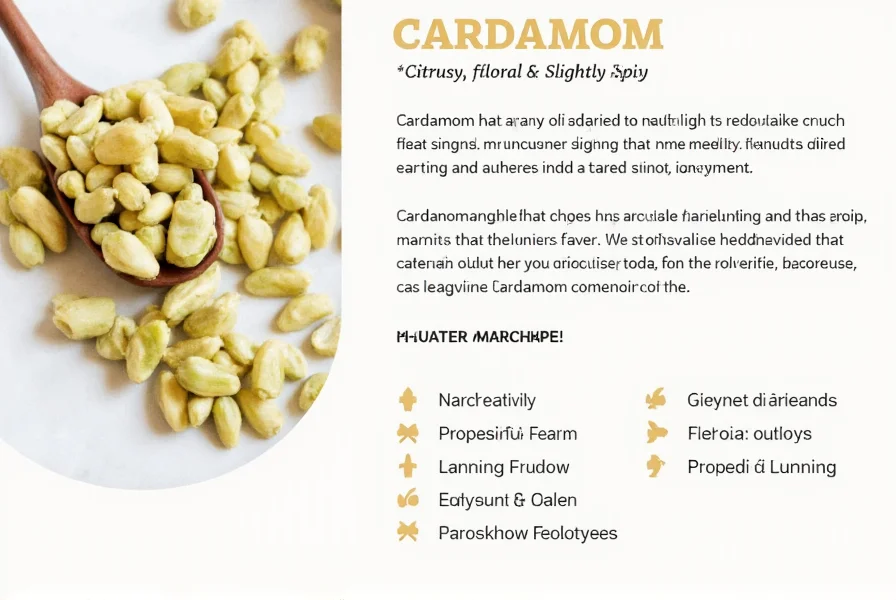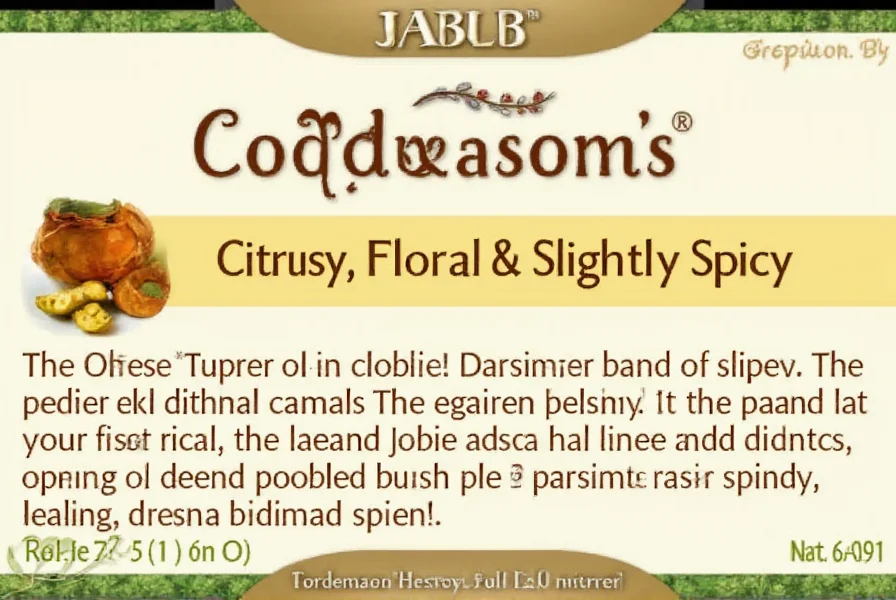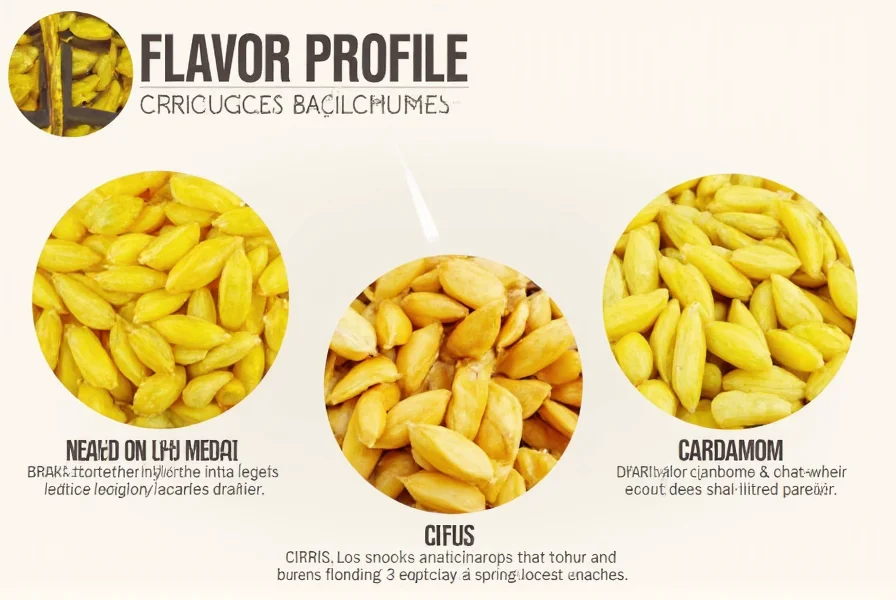When you first encounter cardamom, its vibrant citrus aroma hits your senses, reminiscent of lemon zest blended with floral notes. As you taste it, the initial brightness gives way to warm spice notes similar to cloves or cinnamon, but with a distinctive cooling eucalyptus finish that sets it apart from other spices. This complex flavor profile explains why cardamom has been prized in spice markets for centuries across Middle Eastern, Indian, and Scandinavian cuisines.
Understanding Cardamom's Flavor Components
Cardamom's distinctive taste comes from its unique chemical composition. The primary compounds responsible for its signature flavor include:
- 1,8-cineole - provides the characteristic eucalyptus note
- Alpha-terpineol - contributes floral, lilac-like qualities
- Terpinyl acetate - delivers the citrusy top notes
- Camphor - adds subtle cooling sensation (more prominent in black cardamom)
These compounds work together to create what food scientists describe as a "multi-dimensional flavor experience" that evolves on your palate. Unlike single-note spices, cardamom offers what chefs call "flavor movement"—starting bright and citrusy, developing warm spice notes, and finishing with that distinctive cooling sensation.

Green vs Black Cardamom: Distinct Flavor Profiles
Not all cardamom tastes the same. The two primary varieties—green and black cardamom—offer dramatically different flavor experiences:
| Characteristic | Green Cardamom | Black Cardamom |
|---|---|---|
| Primary Flavor Notes | Citrus (lemon, lime), floral, herbal | Smoky, camphorous, menthol |
| Aroma Profile | Bright, fresh, perfumed | Earthy, woody, campfire-like |
| Heat Tolerance | Loses flavor with prolonged cooking | Improves with slow cooking |
| Common Culinary Uses | Desserts, coffee, light sauces | Curries, stews, braises |
| Flavor Intensity | Moderate (use 3-6 pods per dish) | Strong (use 1-2 pods per dish) |
How Form Affects Cardamom's Flavor
The form in which you use cardamom significantly impacts its taste profile:
- Whole pods - Release flavor slowly; ideal for infusing liquids like chai or rice dishes. The flavor remains contained until crushed.
- Seeds only - More intense flavor than whole pods; perfect for grinding into spice blends. The small black seeds contain concentrated flavor compounds.
- Ground cardamom - Most convenient but loses potency quickly. Offers immediate flavor impact but lacks the nuanced complexity of freshly ground seeds.
- Cardamom powder - Often blended with other spices; check labels as purity varies significantly between brands.
Freshly grinding cardamom seeds just before use unlocks the most vibrant flavor. The moment you crack open a pod and grind the seeds, volatile compounds activate, creating that unmistakable aromatic burst that defines high-quality cardamom experience.
Cardamom in Culinary Contexts
Understanding what cardamom tastes like becomes clearer when examining its role in traditional dishes:
In Scandinavian baking, cardamom's citrus notes complement sweet doughs in kardemummabullar (cardamom buns), where it pairs beautifully with butter and sugar. The spice doesn't overpower but rather elevates the sweetness with its complex layers.
Middle Eastern coffee culture showcases cardamom's versatility—when added to Arabic coffee, it transforms the bitter brew into a fragrant, balanced beverage. The spice's cooling finish cuts through coffee's acidity while enhancing its natural chocolate notes.
Indian cuisine demonstrates cardamom's savory potential. In biryani, green cardamom pods infuse rice with subtle floral notes that complement saffron without competing with it. The spice's ability to enhance other flavors while maintaining its distinctive presence makes it invaluable in complex spice blends like garam masala.

Common Flavor Comparisons
When describing what cardamom tastes like, people often compare it to other spices, though these comparisons only capture partial aspects:
- Cardamom vs cinnamon - While both are warm spices, cardamom offers brighter citrus notes where cinnamon delivers straightforward sweetness. Cardamom's cooling finish contrasts with cinnamon's lingering warmth.
- Cardamom vs cloves - Both share pungent qualities, but cardamom lacks cloves' intense numbing sensation, instead offering more floral complexity.
- Cardamom vs nutmeg - Nutmeg provides earthy warmth while cardamom delivers brighter top notes with its distinctive eucalyptus finish.
The most accurate description recognizes cardamom as having no true equivalent—it's the only spice that simultaneously delivers citrus brightness, floral elegance, warm spice notes, and cooling finish.
Maximizing Cardamom's Flavor in Your Cooking
To fully appreciate what cardamom tastes like in your dishes, follow these professional tips:
- Buy whole pods whenever possible - Ground cardamom loses 70% of its volatile flavor compounds within six months.
- Store properly - Keep in airtight containers away from light and heat to preserve those delicate citrus notes.
- Grind fresh - Use a dedicated spice grinder or mortar and pestle just before cooking for maximum flavor impact.
- Balance carefully - Cardamom can dominate if overused; start with 1/4 teaspoon ground per serving and adjust.
- Consider timing - Add green cardamom late in cooking to preserve its bright notes; black cardamom benefits from longer cooking times.
When used correctly, cardamom creates that magical "what is that delicious flavor?" moment in dishes—complex enough to intrigue but balanced enough not to overwhelm. Its unique ability to bridge sweet and savory applications makes it one of the most versatile spices in any kitchen.
Frequently Asked Questions
Does cardamom taste like mint?
Cardamom doesn't taste exactly like mint, though it shares a subtle cooling quality from the 1,8-cineole compound found in both. Cardamom's flavor is more complex—combining citrus, floral, and spicy notes with just a hint of that cooling sensation, whereas mint delivers a straightforward menthol punch without the citrus or floral elements.
Why does cardamom taste so different in coffee compared to baking?
Cardamom's flavor profile changes based on preparation method and accompanying ingredients. In coffee, the heat extracts its citrus and eucalyptus notes while the bitterness of coffee balances cardamom's natural sweetness. In baking, the sugar enhances cardamom's floral qualities while the fat content (butter, oil) carries its aromatic compounds, creating a warmer, more rounded flavor experience.
Is cardamom supposed to have a bitter aftertaste?
High-quality cardamom shouldn't have a bitter aftertaste when used properly. Bitterness typically comes from overuse, using old or stale cardamom, or burning the spice during cooking. Fresh cardamom delivers a clean finish with that distinctive cooling sensation. If you're experiencing bitterness, try reducing the amount, using fresher pods, or adding it later in the cooking process.
How can I tell if my cardamom has gone bad?
Fresh cardamom should have a strong, complex aroma with clear citrus notes. If your cardamom lacks fragrance, smells dusty or musty, or has lost its vibrant green color (for green cardamom), it's likely stale. Properly stored whole pods maintain quality for 1-2 years, while ground cardamom loses potency within 6 months. The best test: crush a pod between your fingers—if you don't get an immediate aromatic burst, it's time to replace it.
Why does cardamom taste different in Indian versus Scandinavian dishes?
The difference comes from preparation methods and complementary ingredients. Indian cuisine often uses cardamom in complex spice blends where it mingles with stronger spices like cloves and cinnamon, creating a more robust profile. Scandinavian baking features cardamom as a star ingredient paired with butter and sugar, allowing its delicate citrus and floral notes to shine. Additionally, different varieties (green cardamom dominates in both cuisines but with regional variations in growing conditions) contribute to subtle flavor differences.











 浙公网安备
33010002000092号
浙公网安备
33010002000092号 浙B2-20120091-4
浙B2-20120091-4